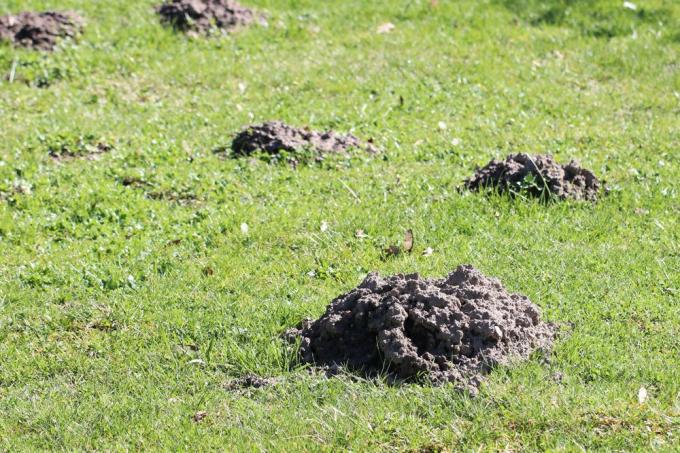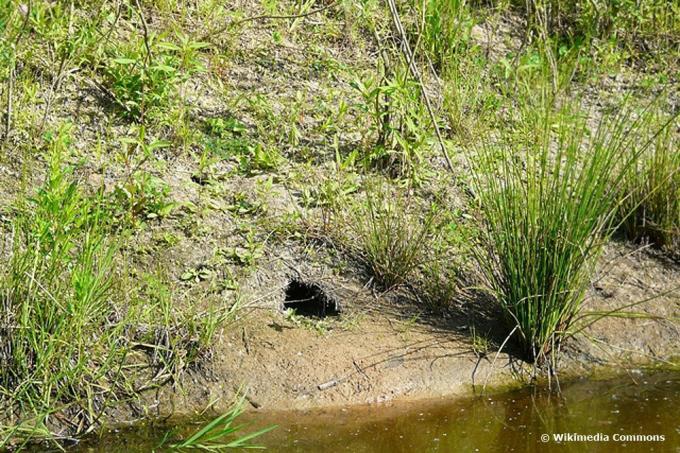
table of contents
- Diet
- Distinguishing features in the buildings
- Size and shape of the hill
- Shape and location of the hole
- Gait system
- Feces
- Dilapidation
Are there heaps of earth in your garden? Then you should first clarify who is the culprit here. In contrast to the vole, the mole is under protection and must not be fought.
Diet
Of the mole (Talpa europaea) is one of the carnivores that feed mainly on earthworms as well as beetles and their larvae. Despite its annoying molehills, it is very useful because it protects the plants in the garden from white grubs, snails and many other pests, as these are on its menu. Voles (Arvicolinae), on the other hand, are pure vegetarians who prefer to enjoy the underground parts of the plant. This can cause serious damage in the home garden Perennials, Flower bulbs, root vegetables or fruit trees.
Distinguishing features in the buildings

It is not that difficult to tell the difference between the two inhabitants of the earth. On closer inspection, only the hills of the two animals look different.
Size and shape of the hill
A mole produces heaps of earth that rise from the ground at regular intervals in the shape of a volcano with a round base. Molehills can reach dimensions of up to 25 centimeters in height and 30 centimeters in width. In contrast to the mole, the mounds of the vole are not only smaller and flatter, but also usually raised asymmetrically. Vole mounds have an elongated base and are found at irregular intervals. Only in autumn can the vole hills turn out a little higher and thus approach the dimensions of molehills.
Tip: While molehills usually consist of clean, loose soil, vole mounds often contain roots or other parts of plants.
Shape and location of the hole
If you move a little away from the earth of the hill, you will see the entrance hole to the construction. Due to the different digging behavior, size and way of life of the animals, these holes not only have a different shape, they are also located in different positions in the hill.

mole
- Hole: in the middle
- Shape: cross-oval
- Corridor runs straight down from the opening
vole
- Hole: on the side
- Shape: highly oval to rounded
- Corridor runs diagonally downwards
Gait system
The mole uses its shovel-shaped front legs to dig its extensive underground tunnel system. The corridors, which reach deep into the ground and often lie on top of each other in several levels, do not seem to follow an orderly system. Usually he just digs in the direction from which he is with his fine hearing or the sensitive nose insects or earthworms. It can happen that the almost blind inhabitant of the earth suddenly changes the direction of the grave. Voles, also known as water voles, live in duct systems that are preferably located very close to the surface of the earth.
Vole outlets

- Location: just below the sward (5-30 cm depth)
- high oval cross-section
- Height: 8 cm
- Width: 5 cm
- gnawed walls (tooth marks visible)
- running straight
- no roots in the corridors
- relatively straight gait system
- Walls smooth, floors rough
Mole passages
- Location: a little deeper in the ground, mostly in several levels one above the other
- cross oval shape (wider than high)
- smaller than the vole
- about two fingers wide
- The gait system is very tortuous, disordered
- interspersed with roots
- Often the cover is loose or brittle
Feces
If you happen to find some droppings from the uninvited garden dweller, clear distinguishing features can also be found here. The excretions of herbivores, to which the voles belong, are criss-crossed by long, indigestible plant fibers. Their legacies consist of many small, oval-shaped fecal balls. Mole droppings, on the other hand, are usually shaped as a single, longer strand and are relatively homogeneous.
Dilapidation

right: vole holes
If you still do not know for sure whether you are dealing with a mole or a vole, the so-called tumble test can help. To do this, dig up the duct system in a few places. When a passage is opened, the two animals react very differently. Voles check the tunnels at short intervals. If one is exposed, they usually close the openings again within a short period of time and dig up the area to the side. In the case of moles, however, this can take several days. Unlike voles, they close the opening by undermining it.
Voles
- after minutes to hours
- plug-like closure
moles
- usually only after several days
- Closure by undermining
- Cover loose and brittle
Note: Moles use some of their tunnels only once, so in this case the opening remains unlocked.
